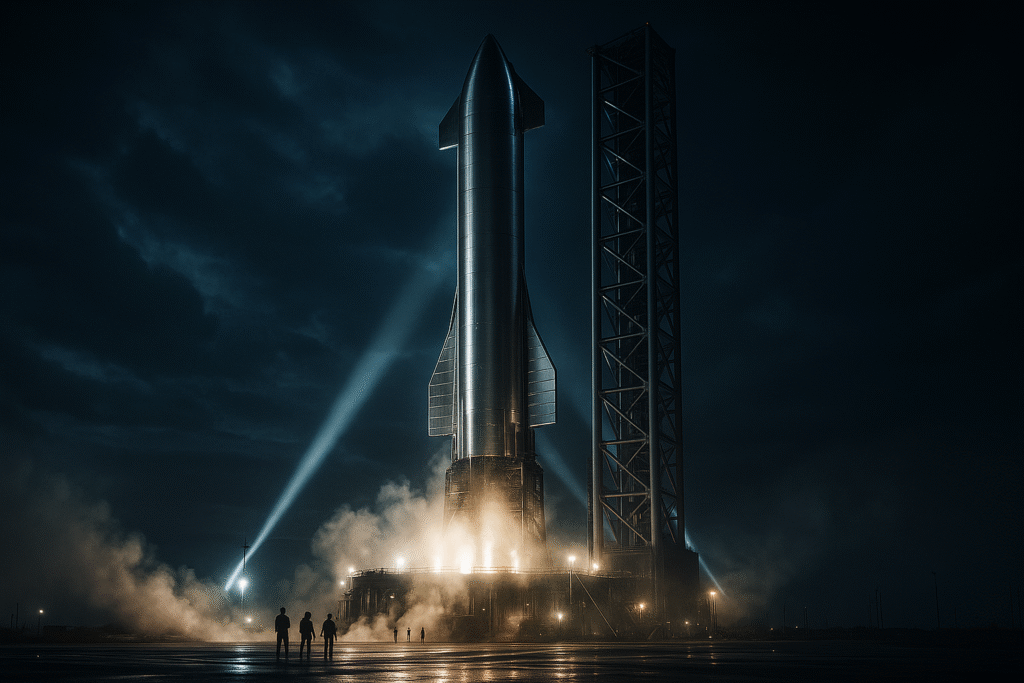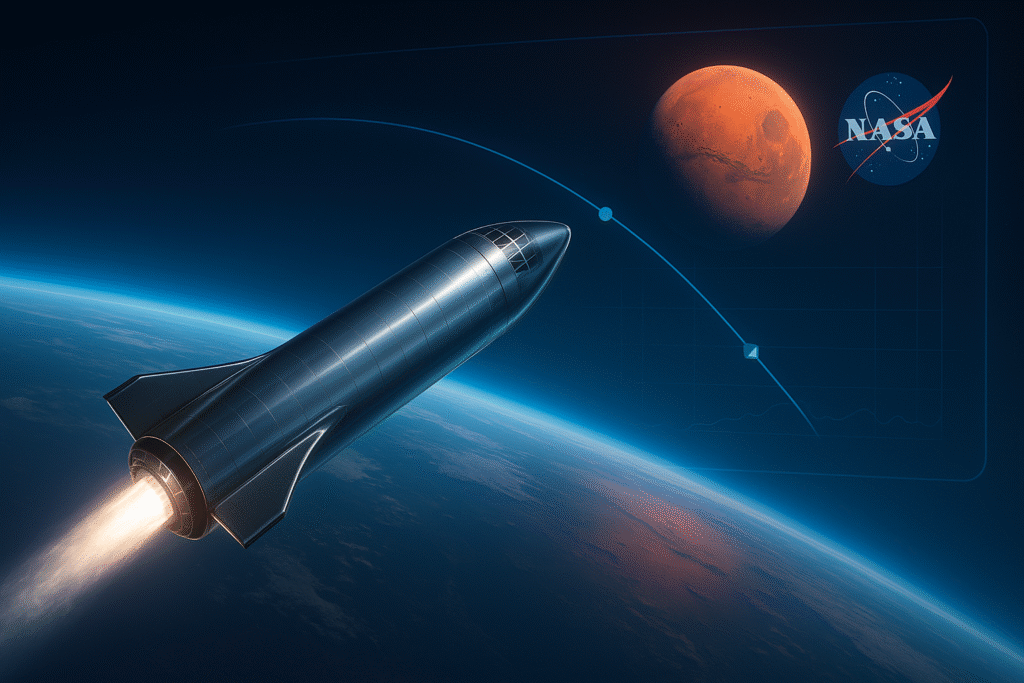
The confirmed SpaceX Starship launch date for its next orbital test flight is one of the most anticipated events in spaceflight for 2025. After the partially successful Starship Flight 9 in April 2025, SpaceX plans additional launches this year, including a historic liftoff from Florida. As Starship evolves into the world’s most powerful and reusable rocket, its progress directly impacts NASA’s Artemis program, global satellite deployments, and the future of Mars missions.
✅ Focus Keyphrase: SpaceX Starship launch date
🚀 Starship Test Flights in 2025: Where Are We Now?
Starship Flight 9 (April 2025): A Major Leap Forward
On April 6, 2025, Starship Flight 9 lifted off from Boca Chica, Texas, in what SpaceX hailed as its most successful orbital test to date. This mission demonstrated:
- Improved engine performance (33 Raptor engines firing simultaneously)
- Full-stack integration with Super Heavy booster
- Successful stage separation and controlled descent
- Partial success in orbital velocity testing
While the upper stage did not complete a full orbital coast, Flight 9 showed substantial improvements in structural integrity and heat shield resilience compared to previous missions.
📎 Related reading: How AI Is Transforming Industries in 2025
Why These Test Flights Matter
These incremental advances are crucial. SpaceX is working to validate Starship for multiple high-stakes objectives:
- NASA’s Artemis program (lunar lander variant)
- Commercial satellite deployment
- Interplanetary missions to Mars
With the Starship megarocket standing at nearly 120 meters, it is the tallest and most powerful launch vehicle ever developed, capable of delivering more than 100 metric tons to orbit.
🌎 SpaceX Starship Florida Launch: What to Expect
Elon Musk confirmed that SpaceX plans a Starship launch from Florida by late 2025, pending regulatory approval from the FAA and environmental assessments at Kennedy Space Center’s LC-39A.
Key Developments:
- Launch pad modifications underway
- Tank farm construction near completion
- First orbital flight from Florida expected Q4 2025
This Florida launch will mark a turning point, allowing increased launch cadence and dual-site operations—Texas and Florida.
🔗 Read more: EU AI Act Compliance Strategies 2025
🛰️ NASA, Artemis & the Role of Starship
NASA selected a lunar-optimized version of Starship as the human landing system (HLS) for Artemis III, scheduled for 2026–2027. SpaceX must prove Starship’s reliability, life support readiness, and in-orbit refueling capability.
Key integration goals include:
- Uncrewed landing rehearsals in 2025–2026
- Tanker variants for on-orbit fuel transfer
- Human-rated flight safety certification
Starship’s massive cargo bay and reusability offer a cost-effective solution for Moon missions and, eventually, Mars colonization.
📈 Technical Specs and Evolution of Starship
| Feature | Starship 2025 Version | Falcon 9 (Reference) | NASA SLS Block 1 |
|---|---|---|---|
| Height | 120m | 70m | 98m |
| Payload to LEO | 100–150 tons | 22.8 tons | 95 tons |
| Engines | 33 Raptor V2 (booster) | 9 Merlin | 4 RS-25 + 2 Solid Boosters |
| Reusability | Full | Partial (booster only) | None |
| Launch Cost (Est.) | <$10 million (goal) | ~$67 million | >$2 billion |
SpaceX aims to drive launch costs down by 10X while scaling mission capacity. This represents a monumental shift for commercial and government space programs.
🌐 Global Implications of Starship’s Progress
1. Satellite Deployment at Scale
Starship can deploy entire satellite constellations in a single launch, reducing time and cost.
2. Moon Base Supply Chain
NASA’s Artemis base camp plans will rely on Starship’s large cargo capacity to deliver habitats, rovers, and supplies.
3. Mars Missions & Colonization
SpaceX envisions crewed Mars missions by 2030. 2025–2026 test flights will validate key systems such as heat shielding, life support, and ISRU (in-situ resource utilization).
🧠 AI in SpaceX Starship Development
SpaceX uses machine learning and AI to:
- Optimize flight trajectories in real-time
- Run simulations for rocket engine performance
- Automate diagnostics and failure prediction
This aligns with broader trends in the aerospace sector, where AI-driven systems are becoming essential for mission planning and anomaly detection.
🔗 Also read: Top AI Tools to Improve Your Credit Score in 2025
📅 Upcoming Launches & Timeline for 2025–2026
| Launch Event | Date Estimate | Objective |
|---|---|---|
| Starship Flight 10 | June 2025 | Second orbital attempt from Texas |
| First Florida Test Launch | Q4 2025 | Orbital flight from Kennedy Space Center |
| Uncrewed Lunar Simulation | Q1 2026 | Starship Moon Lander test |
| First On-Orbit Refueling | Mid-2026 | Tech demo with tanker variant |
| Artemis III Integration | Late 2026–2027 | NASA crewed mission |
🌟 Final Thoughts: Why Starship Matters

SpaceX’s progress with Starship in 2025 is not just about bigger rockets—it’s about unlocking an entirely new paradigm for space access. Whether it’s delivering cargo to the Moon, ferrying satellites, or enabling Mars colonization, Starship’s design, scale, and ambition make it the most important space vehicle of the decade.
As the next test flights approach and NASA’s Artemis plans solidify, staying informed about SpaceX Starship launch dates, technology updates, and policy implications is crucial for space enthusiasts, investors, and aerospace professionals alike.




Very informative and fantastic complex body part of written content, now that’s user genial (:.
I saw a lot of website but I conceive this one holds something special in it in it